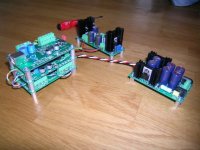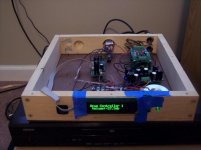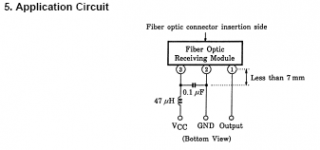USB Module, DAC, Ballsie stack with supplies, getting ready to test the Ballsie out. Tested configs will be:
Balanced out, no filter (balanced output buffer)
SE out, no filter (Bal-SE converter/buffer)
Balanced out with Filter (filter/buffer)
SE out with filter (convert/filter/buffer)
Balanced out, no filter (balanced output buffer)
SE out, no filter (Bal-SE converter/buffer)
Balanced out with Filter (filter/buffer)
SE out with filter (convert/filter/buffer)
Attachments
Ok its ugly, but....
Just wanted to show my test rig using a uC to control the Opus. Basically it just initializes it and sets the volume via IR (phillips RC5). I also coded a mute function. It will also have rotary encoder(gray code) input as well.
This was just for kicks. Later I will interface the Opus with uber controller. 🙂
I have the DAC directly DC coupled to a TXO-2. This sounds freakin incredible.
Cheers!
Russ
Just wanted to show my test rig using a uC to control the Opus. Basically it just initializes it and sets the volume via IR (phillips RC5). I also coded a mute function. It will also have rotary encoder(gray code) input as well.
This was just for kicks. Later I will interface the Opus with uber controller. 🙂
I have the DAC directly DC coupled to a TXO-2. This sounds freakin incredible.

Cheers!
Russ
Attachments
Any idea when that LCD controller kit is going to be ready? I'm very interested in that thing 😀
Dougie085 said:Any idea when that LCD controller kit is going to be ready? I'm very interested in that thing 😀
Well what you see there is really a hacked up Joshua Tree Controller. 🙂
Controlling the DAc is actually wicked easy if you can program a PIC. There are just 5 registers, and they are actually pretty intuitive.
I can send the code to anyone who is interested. It not yet perfected, for instance I have not used the interrupt pin effectively yet. But it is certainly serviceable and will get you going in the right direction.
Cheers!
Russ
Going to be building a preamp of some sort soon and very interested in your LCD controller. I'm guessing its a selector as well.
Has anyone been able to get optical in functioning? I looked at the data sheets for my torx receiver and the cs8416 reference board to figure out how to hook it up. I've got the output of the torx going through a .1 or .01 uF x7r cap (forget which) and connected to the receiver side of C4 (easiest spot I could find for input directly to RX0). It doesn't work, so I thought I'd try to get some ideas here (yes, I have a voltage regulator using the proper circuit to power the torx).
Re: Re: Computer to USB module to ...?
Russ,
I am new and was looking for the complete from input to whatever to the switch, to dac (or..?) eventually to the analog output. I want to share the OPUS.
Not sure what you mean by this.
Thank you for your time,
Darren
Russ White said:
We are working on a I2S multiplexer for sharing multiple sources with a single DAC , its not done yet, but for now you could also just use a 4 pole switch.
The chain for USB could just be the USB module(very good but not optimal), or USB -> Opus DAC.
Good luck!
Cheers!
Russ
Russ,
I am new and was looking for the complete from input to whatever to the switch, to dac (or..?) eventually to the analog output. I want to share the OPUS.
Russ White said:
The chain for USB could just be the USB module(very good but not optimal),
Not sure what you mean by this.
Thank you for your time,
Darren
BrianDonegan said:I think you want to just tie the TORX output to the regular S/PDIF input (+) and GND.
Great, that worked. Thanks, Brian. That's what I get for trying to come up with a solution that's much more complicated than needed.
PSU options?
I am planning to use the Opus and Ballsie (balanced and SE), but wonder if there is a single power supply board to be used for both, or is it two discrete boards?
I am planning to use the Opus and Ballsie (balanced and SE), but wonder if there is a single power supply board to be used for both, or is it two discrete boards?
Re: PSU options?
You *COULD* actually use just the dual PS(+/-12V) and run the DAC off of the positive rail. The DAC has its own VREGs, so that will work fine.
It would be better to use one LCPS so that the digital and analog supplies for the DAC are complete separate from the supply for the ballsie. How much of a difference it would make, I have no idea.
Cheers!
Russ
pabbi1 said:I am planning to use the Opus and Ballsie (balanced and SE), but wonder if there is a single power supply board to be used for both, or is it two discrete boards?
You *COULD* actually use just the dual PS(+/-12V) and run the DAC off of the positive rail. The DAC has its own VREGs, so that will work fine.
It would be better to use one LCPS so that the digital and analog supplies for the DAC are complete separate from the supply for the ballsie. How much of a difference it would make, I have no idea.
Cheers!
Russ
I've read through this thread and I still have some basic questions about the USB interface. Sorry if these are elementary, but I honestly didn't see the answer.
1) What are the software requirements? Or, perhaps more correctly, is there a compatibility list (ie. WinXP, OSX, ALSA, OSS, JACK, etc.)?
2) As I understand it when you connect the DAC to an S/PDIF source it gets it's clock from the S/PDIF transmitter. Where does the USB interface receive it's clock from? Is it possible to connect an external clock?
3) Is it possible to expand the USB interface to include more than 2 channels? (My guess it not in the current implementation, but this could be a great future add)
4) Just a general question that doesn't really have anything to do with this project per say. Are there any DIY ADC or wordclock projects? Why not?! =)
1) What are the software requirements? Or, perhaps more correctly, is there a compatibility list (ie. WinXP, OSX, ALSA, OSS, JACK, etc.)?
2) As I understand it when you connect the DAC to an S/PDIF source it gets it's clock from the S/PDIF transmitter. Where does the USB interface receive it's clock from? Is it possible to connect an external clock?
3) Is it possible to expand the USB interface to include more than 2 channels? (My guess it not in the current implementation, but this could be a great future add)
4) Just a general question that doesn't really have anything to do with this project per say. Are there any DIY ADC or wordclock projects? Why not?! =)
Hi m0tion
I believe the PCM2707 works just fine under Linux(ALSA), but I will be able to confirm this soon.
Most of your questions are answered in the PCM2707 datasheet. The PCM2707 generates its own clock in part using a 12mhz crystal.
I do believe you can use more than one USB module at a time as reported in this post:
http://www.diyaudio.com/forums/showthread.php?postid=1268236#post1268236
I have not had a chance to try it yet.
As for ADC, I have contemplated it, and I probably will actually have the need here soon as I progress toward DSP projects and active filters etc. So who knows...
Cheers!
Russ
I believe the PCM2707 works just fine under Linux(ALSA), but I will be able to confirm this soon.
Most of your questions are answered in the PCM2707 datasheet. The PCM2707 generates its own clock in part using a 12mhz crystal.
I do believe you can use more than one USB module at a time as reported in this post:
http://www.diyaudio.com/forums/showthread.php?postid=1268236#post1268236
I have not had a chance to try it yet.
As for ADC, I have contemplated it, and I probably will actually have the need here soon as I progress toward DSP projects and active filters etc. So who knows...
Cheers!
Russ
m0tion said:
4) Are there any DIY ADC or wordclock projects? Why not?! =)
No demand.
Re: USB I2S module tested...
http://www.diyaudio.com/forums/showthread.php?postid=1280778#post1280778
In this image is the module set to S/PDIF?
http://www.diyaudio.com/forums/showthread.php?postid=1280778#post1280778
In this image is the module set to S/PDIF?
Sorry I see that now. The chip is upside down in that picture and it threw me off...
So, the actual DAC module support 192khz, but the USB module only seems to support 48khz. Is this the highest quality way to get audio out of the PC or would it be better to use your PC's S/PDIF output?
I would think the big benefit to using USB would be to avoid having to use your sound card's clock, but the clock included with the USB module doesn't seem to be much better. Am I wrong here?
So, the actual DAC module support 192khz, but the USB module only seems to support 48khz. Is this the highest quality way to get audio out of the PC or would it be better to use your PC's S/PDIF output?
I would think the big benefit to using USB would be to avoid having to use your sound card's clock, but the clock included with the USB module doesn't seem to be much better. Am I wrong here?
m0tion said:Sorry I see that now. The chip is upside down in that picture and it threw me off...
So, the actual DAC module support 192khz, but the USB module only seems to support 48khz. Is this the highest quality way to get audio out of the PC or would it be better to use your PC's S/PDIF output?
I would think the big benefit to using USB would be to avoid having to use your sound card's clock, but the clock included with the USB module doesn't seem to be much better. Am I wrong here?
The clock on the USB module should actually be pretty good. Have not scoped it yet to see. The major design point however, is that it can output I2S direct to the DAC without using SPDIF.
You may indeed be able to get higher bandwidth from a soundcard that supports it, and thats fine. Our primary design goal is to support 44.1/16 audio.
Cheers!
Russ
- Home
- More Vendors...
- Twisted Pear
- Mr White's "Opus", designing a simple balanced DAC


